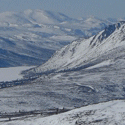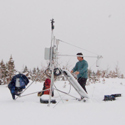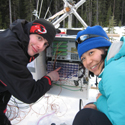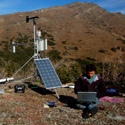|
IP3 Science
The hydrological cycle is complicated in cold regions by the storage of water in
its solid state:
in order to quantify water resources, or to provide advance warning of extreme
conditions such as drought or flood,
it is
is essential to
understand the physical controls which govern the rate and timing of transitions
between
snow or ice and liquid water or water vapour. Thus far, these systems have been
understood only relatively poorly.
The principal objective of the IP3
research programme is to improve understanding of the interaction between
atmospheric, land-surface, biophysical and hydrological systems,
in order to build enhanced
predictive models,
thereby enabling more accurate quantification of water
resources in cold regions.
High-level synopses of IP3's scientific approach are available from
brochures (published in English and Français), and
the 'IP3 Primer'.
More detailed descriptions are provided in pages found by following the links
listed below.
IP3 science is
organised into three eponymous themes;
Theme 1:
Processes
Theme Lead: Sean Carey (e-mail; www), Carleton University
The first task is to improve our understanding of the key physical processes
involved in the hydrometeorology of cold regions, through intensive and
extensive observation and analysis of the physical characteristics and
interactions of climate and weather,
the
cryosphere,
land surface and sub-surface, water bodies and the biosphere, in a
range of high-latitude / high-altitude research basins.
Theme 2:
Parameterisation
Theme Lead: Bill Quinton (e-mail; www),
Wilfrid Laurier University
Having observed and described the processes at work in the coupled
atmospheric-hydrological systems of cold regions, the next step is to identify
the set of variables and constants which control their activity, and to derive
and refine mathematical formulae and algorithms through which they may be
represented in numerical models.
Theme 3:
Prediction
Theme Lead: Alain Pietroniro (e-mail; www), University of Saskatchewan
The ultimate aim is to integrate these strands of process-level representation,
combining the individual high-resolution models into synoptic systems which
provide enhanced predictive capabilities at scales ranging from local (sub-kilometric to ~10km resolution) to regional (10s to 100s of km). With testing
and validation, these models will provide improved prediction and simulation of
water resources in response to atmospheric impacts in cold regions.
Progress towards these goals is described in the network's annual science
reports;
-
Year 1 (2006-2007)
-
Year 2 (2007-2008)
-
Year 3 (2008-2009)
IP3 is also making a significant contribution to the
International Polar Year 2007-8:
details are available here.
|
















